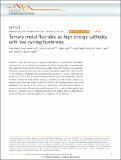Ternary metal fluorides as high-energy cathodes with low cycling hysteresis
Author(s)
Wang, Feng; Kim, Sung-Wook; Seo, Dong-Hwa; Kang, Kisuk; Wang, Liping; Su, Dong; Vajo, John J.; Wang, John; Graetz, Jason; ... Show more Show less
DownloadWang-2015-Ternary metal.pdf (2.609Mb)
PUBLISHER_CC
Publisher with Creative Commons License
Creative Commons Attribution
Terms of use
Metadata
Show full item recordAbstract
Transition metal fluorides are an appealing alternative to conventional intercalation compounds for use as cathodes in next-generation lithium batteries due to their extremely high capacity (3–4 times greater than the current state-of-the-art). However, issues related to reversibility, energy efficiency and kinetics prevent their practical application. Here we report on the synthesis, structural and electrochemical properties of ternary metal fluorides (M[1 over y]M[2 over 1-y]F[subscript x]: M[superscript 1], M[superscript 2]=Fe, Cu), which may overcome these issues. By substituting Cu into the Fe lattice, forming the solid–solution Cu[subscript y]Fe[subscript 1-y]F[subscript 2], reversible Cu and Fe redox reactions are achieved with surprisingly small hysteresis (<150 mV). This finding indicates that cation substitution may provide a new avenue for tailoring key electrochemical properties of conversion electrodes. Although the reversible capacity of Cu conversion fades rapidly, likely due to Cu[superscript +] dissolution, the low hysteresis and high energy suggest that a Cu-based fluoride cathode remains an intriguing candidate for rechargeable lithium batteries.
Date issued
2015-03Department
Massachusetts Institute of Technology. Department of Materials Science and EngineeringJournal
Nature Communications
Publisher
Nature Publishing Group
Citation
Wang, Feng, Sung-Wook Kim, Dong-Hwa Seo, Kisuk Kang, Liping Wang, Dong Su, John J. Vajo, John Wang, and Jason Graetz. “Ternary Metal Fluorides as High-Energy Cathodes with Low Cycling Hysteresis.” Nature Communications 6 (March 26, 2015): 6668. © 2015 Macmillan Publishers Limited
Version: Final published version
ISSN
2041-1723